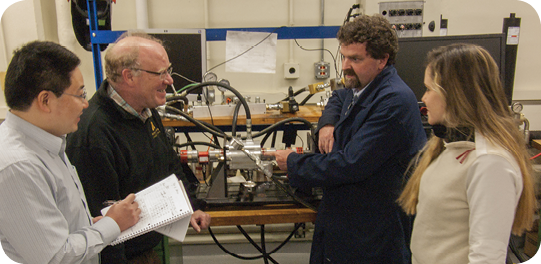Hydraulic drives once held great promise for utility scale wind turbines because they allowed getting rid of the troublesome gearbox, a giant step toward greater reliability. The cost of power is one deciding factor, so few large hydraulic drives were built. One exception, Mitsubishi’s Sea Angel in Japan, is slated for launch this year.
But there are good reasons to give hydraulic drives a closer second look. “For instance, there is some compressibility in the fluid that prevents shock loading to the generator,” says University of Minnesota and Mechanical Engineering Professor Kim Stelson. “And hydraulics equipment is lighter than the conventional equipment it replaces. Also, control is somewhat simplified. Controls in a conventional turbine are based on torque, a quantity that can be difficult to measure, although it can be approximated with current. But in a hydraulic transmission you measure it with pressure from the pump and that is more convenient.” Also, costly power inverters could be eliminated.

A hydrostatic drive in a wind turbine would use a slow-turning rotor to drive a pump that would power a motor to turn the generator at a constant speed and thereby eliminate some of the power inverters common to conventional turbine designs.
OK, but if utility scale turbines are not the ideal short term opportunity, what is? “Many companies make small wind turbines that output less than 100 kW, but the mid-wind category, 100 to 1,000 kW, is an under-served sector and hence provides greatest opportunity.” He adds that NREL engineers confirm his analysis.
Furthermore, variable wind power on the utility grid means the utilities have to consider upgrading transmission lines and storage issues because of the variable nature of renewable energy. “But for applications such as rural electric cooperatives, factories, farms, and hospitals with favorable wind, it is possible to economically generate power and use it immediately so it’s not put back into the grid. This lessens demand and grid load,” says Stelson.
To take advantage of recent developments, Stelson and post-doctoral student Feng Wang have been working on a test stand that will allow examining hydraulic devices and control algorithms for midsized turbines.
After several years of research, Stelson’s team now focuses on testing and developing a hydrostatic drive train, one that uses a constant-volume pump to drive a variable-volume motor to turn the generator. Initial tests also found that an accumulator – a hydraulic device that allows capturing pressurized fluid when the system does not need it – lets the system increase annual energy output by about 4%.

Kim Stelson’s research team includes (left to right) Feng Wang, post-doc student at the University of Minnesota, Stelson, Rob Price, an engineer from Mathers Hydraulics, and Emma Frosina, Ph.D. student from the University of Naples, Italy.
Stelson adds that the highest power hydraulic pump commercially available is rated at 800 kW, the high side of the mid-range target. Anything above that is custom. The company Hagglunds, a subsidiary of Bosch Rexroth, makes that large a hydraulic motor, and with a minor modification, it can be driven by a turbine rotor as a pump.
“To increase efficiency we are beginning to investigate hydro-mechanical transmissions. A novel hydro-mechanical design is being developed in cooperation with an Australia company, Mathers Hydraulics,” says Stelson.
The test platform is not quite complete. “We have to build a few fixtures and should be announcing its opening about the time you publish this,” he says. The modular test platform will let the team examine different control algorithms and components, and different operating conditions. An electric motor simulates rotor torque. And placing one hydrostatic drive inside another allows directing output power of one to the input of the other. As a result, the laboratory only needs to buy power to overcome inefficiencies. That allows, for example, testing a 250-kW transmission with a 50 kW electric motor.
What’s next? Testing opens a new frontier, says Stelson. “We’ll also test fluids and eventually make comparisons with the new hydro-mechanical drive we are developing with Mathers.” WPE
Filed Under: News, Turbines





